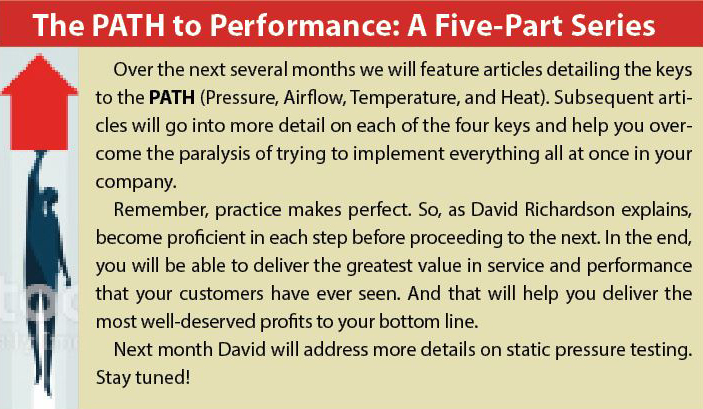It takes commitment and discipline to implement HVAC airside performance testing. One of the biggest obstacles is to decide where to start. With so many options, it can drive you crazy figuring out what should come first. I’ve found one concept that I call PATH which helps prioritize skills you must learn to master system performance.
PATH is an acronym for Pressure, Airflow, Temperature, and Heat. These are the components that airside performance revolves around. Think of each piece as a step on your pathway to building extraordinary HVAC systems. The acronym also represents a sequential way you can add testing, diagnostics, and system upgrades to your HVAC service offerings.
This article is the first in a five-part series on the concepts of PATH and how to make it part of your company. In this first part, we will overview each step and offer some simple ways to get started. The remaining articles will dive deeper into the meaning of each PATH letter. By the end of the series, you will have some simple and practical ways to easily apply and prioritize these principles for your sales, service, and installation.

Pressure
Static pressure is the first step on the airside performance path. It is a foundation for airside performance and an indicator of overall HVAC system health.
Total external static pressure (TESP) (ncilink.com/HartmanTESP) is the first test to master. It uncovers hidden airflow restrictions that lead to premature equipment failure and comfort issues. To diagnose TESP, compare your measured TESP to the maximum-rated TESP found on the equipment nameplate. If measured TESP exceeds rated TESP, you need to investigate further to figure out why.
A simple blood pressure comparison can help you understand why it’s important. High static pressure ‘ just like high blood pressure ‘ means you are getting ready to have major issues and are probably not healthy.
To help visualize this relationship, you can use the NCI Static Pressure to Blood Pressure Tables. If you are a registered user of the National Comfort Institute (NCI) website, you can download a copy at ncilink.com/SPtoBP.
If not registered, it is easy and free to do so. Just go to ncilink.com/NCIWebReg and sign up.
Airflow
Airflow is the second step on the PATH to performance. It is key to a well-performing and long-lasting system. Without it, you won’t achieve rated efficiency and the system will suffer long-lasting negative effects.
Many customers have endured low airflow issues for years but never had it pointed out through measurement. You can plot fan airflow on a fan table to begin the troubleshooting process.
Once you measure TESP, plot it with the fan speed setting on a fan table to estimate fan airflow. This helps you see approximately how much air the fan is moving.
To diagnose, compare plotted fan airflow (ncilink.com/PlotFanAir) to what the equipment needs for proper operation. You can also look at a fan table to see the relationship between elevated static pressure and airflow.

Temperature
Temperature is the third step. It is an important aspect of system performance that you might overlook. The air handling equipment could have correct airflow, but without proper temperatures, comfort and efficiency won’t happen.
Start with four temperature measurements to see how much influence the duct system has on the system’s delivery of comfort and efficiency. Measure the following air temperatures while the system is running to show their impact:
- Temperature entering equipment
- Temperature leaving the equipment
- The temperature at the farthest supply register
- The temperature at the farthest return grille.
Click below for the next page:













Recent Comments